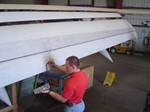Low-cost ultrasonic NDT method yields real-time results
Ultrasonic nondestructive inspection methods are based on the principle of wave propagation through a solid medium. A transmitter emits a sound wave, above the range audible to humans, that excites the structure, while the same (or a second) transducer picks up the resulting structural waves. In a typical setup, a C
The DAV excites a large-area, unfocused transducer, which generates a collimated plane wave. As the resulting wave strikes the target and scatters, an acoustic lens collects the scattered energy and focuses it onto an ultrasound-sensitive detector array in either through-transmission mode or "pulse echo" mode, in which the transducer is at an angle to the part surface. The camera is placed in intimate contact with the part via an acoustic coupling gel or compliance pads or membranes; the camera housing is water-filled to minimize signal attenuation.
The technology has been tested by the U.S. Air Force Air Mobility Battlelab (Ft. Dix, N.J.) and by a commercial aircraft OEM. In the latter case, a 26-inch by 7-inch (660 mm by 178 mm) monolithic carbon/epoxy test panel, varying in thickness from 0.375 inch to 1.5 inches (9.5 mm to 38.1 mm), was constructed with known defects. The Imperium I500 Acoustocam device, in pulse echo configuration, enabled the examiner to view the sample at various depths in real time, at 30 frames per second, to 0.02 inch/0.5 mm resolution, says Lasser. Including setup, the scan was completed within 15 minutes.
Related Content
-
Robotic NDT inspection solutions, services enhance multitasking capabilities
CAMX 2024: Matec Instrument Companies Inc. presents its range of nondestructive ultrasonic testing technologies, including robotic inspection systems for increased efficiency and reduced physical strain.
-
Ruckus Composites, Aerospace grows in-house composites machining, measurement and inspection
Recent in-house technology investments set Ruckus up to meet advanced composite inspection and precision machining demand.
-
Innovation in ultrasonic inspection and nondestructive testing
With increasingly complex structural components working their way into aerospace programs, the need for versatility in inspection and testing capabilities is growing.


